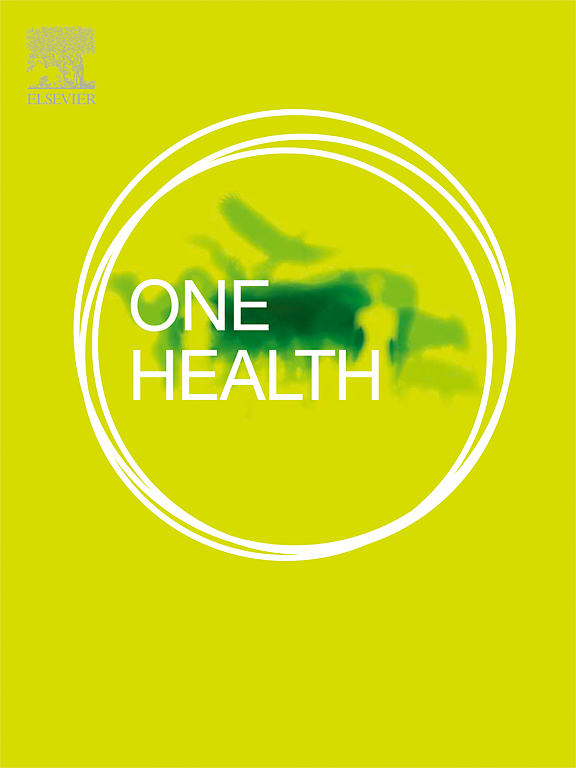Ecology and epidemiology of multidrug-resistant Salmonella in synanthropic small mammals in Bangladesh
IF 4.1
2区 医学
Q1 INFECTIOUS DISEASES
引用次数: 0
Abstract
Multidrug resistant (MDR) organisms pose a significant global concern, affecting both human and animal health. Synanthropic small mammals, such as rodents and shrews can serve as environmental reservoirs and vectors for MDR organisms, including Salmonella spp. Hence, a cross-sectional study was conducted to estimate the prevalence, risk factors, and MDR patterns of Salmonella spp. in wild rodents and shrews across diverse ecological settings in Bangladesh. Throat and rectal/fecal swab samples were collected from a total of 350 mammals (203 wild rodents and 147 shrews) and tested for Salmonella spp. using selective culturing, biochemical properties and PCR. All isolates were tested for culture susceptibility using the Kirby-Bauer disc diffusion method for 17 antimicrobials. Our findings revealed the overall prevalence of MDR Salmonella spp. was 38.6 % (95 % CI: 33.5–44.0). Prevalence was highest in S. murinus (61.2 %), followed by B. bengalensis (35.9 %), M. musculus (29.4 %) and R. rattus (29.0 %). The resistance of the isolated Salmonella strains in descending order was: 100 % to ampicillin and oxytetracycline, followed by 94 % to sulfamethoxazole-trimethoprim, 92.0 % to doxycycline, and 89.0 % to ciprofloxacin. Shrews had significantly higher odds of carrying MDR Salmonella (OR = 3.8, p < 0.01) compared to rodents. Moreover, small mammals from human dwellings had greater odds (OR = 2.4, p < 0.01) of carrying MDR Salmonella than agricultural lands. Resistance to ceftriaxone and azithromycin is particularly concerning, as these are critical for treating human infections with third generation cephalosporin and macrolides. These findings underscore the importance of enhanced reduced environmental contamination and judicious use of antibiotics to prevent spillovers of MDR organisms from wildlife to people and livestock.
孟加拉国合生小型哺乳动物中耐多药沙门氏菌的生态学和流行病学
耐多药生物(MDR)是一个全球性的重大问题,影响着人类和动物的健康。啮齿动物和鼩鼱等共生小型哺乳动物可作为包括沙门氏菌在内的耐多药耐药性生物的环境宿主和媒介。因此,我们开展了一项横断面研究,以估计孟加拉国不同生态环境下野生啮齿动物和鼩鼱中沙门氏菌的流行率、危险因素和耐多药耐药性模式。收集350只哺乳动物(203只野生啮齿动物和147只鼩鼱)的咽喉和直肠/粪便拭子样本,采用选择性培养、生化特性和PCR检测沙门氏菌。采用Kirby-Bauer圆盘扩散法对17种抗菌素进行培养敏感性试验。我们的研究结果显示,耐多药沙门氏菌的总体患病率为38.6% (95% CI: 33.5-44.0)。鼠鼠患病率最高(61.2%),其次是白腹小蠊(35.9%)、鼠鼠(29.4%)和家鼠(29.0%)。沙门氏菌对氨苄西林和土霉素的耐药率由高到低依次为100%、94%、92.0%、89.0%。鼩鼱携带耐多药沙门氏菌的几率明显更高(OR = 3.8, p <;0.01)。此外,来自人类住所的小型哺乳动物患病几率更大(OR = 2.4, p <;耐多药沙门氏菌携带率比农田高0.01)。对头孢曲松和阿奇霉素的耐药性尤其令人担忧,因为它们对于用第三代头孢菌素和大环内酯类药物治疗人类感染至关重要。这些发现强调了加强减少环境污染和明智使用抗生素以防止耐多药微生物从野生动物向人类和牲畜溢出的重要性。
本文章由计算机程序翻译,如有差异,请以英文原文为准。
求助全文
约1分钟内获得全文
求助全文
来源期刊

One Health
Medicine-Infectious Diseases
CiteScore
8.10
自引率
4.00%
发文量
95
审稿时长
18 weeks
期刊介绍:
One Health - a Gold Open Access journal.
The mission of One Health is to provide a platform for rapid communication of high quality scientific knowledge on inter- and intra-species pathogen transmission, bringing together leading experts in virology, bacteriology, parasitology, mycology, vectors and vector-borne diseases, tropical health, veterinary sciences, pathology, immunology, food safety, mathematical modelling, epidemiology, public health research and emergency preparedness. As a Gold Open Access journal, a fee is payable on acceptance of the paper. Please see the Guide for Authors for more information.
Submissions to the following categories are welcome:
Virology,
Bacteriology,
Parasitology,
Mycology,
Vectors and vector-borne diseases,
Co-infections and co-morbidities,
Disease spatial surveillance,
Modelling,
Tropical Health,
Discovery,
Ecosystem Health,
Public Health.
 求助内容:
求助内容: 应助结果提醒方式:
应助结果提醒方式:


